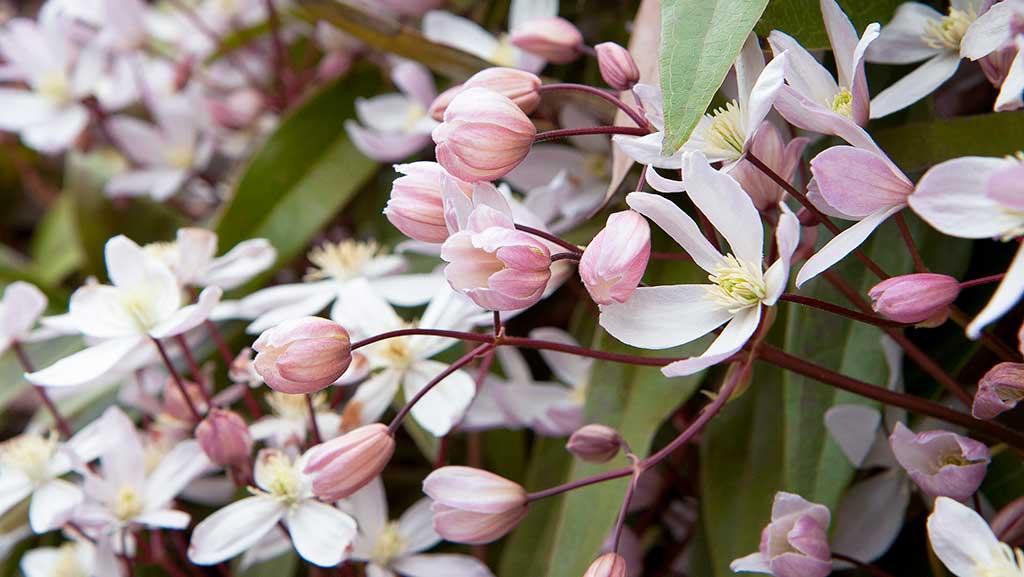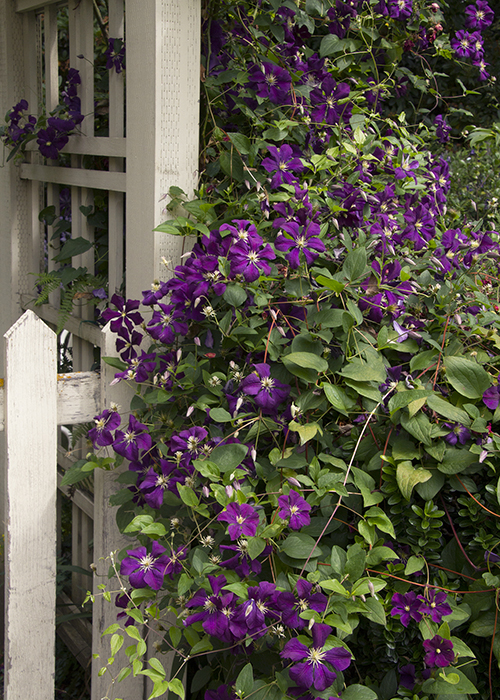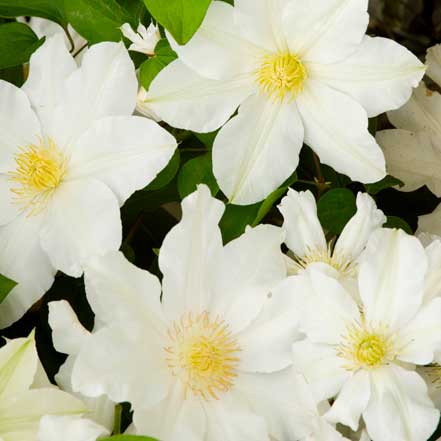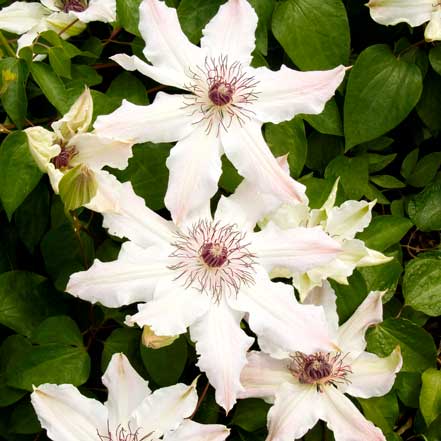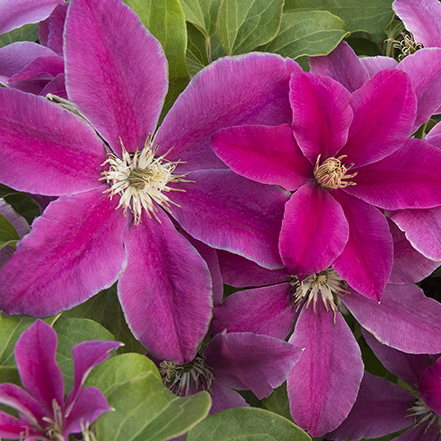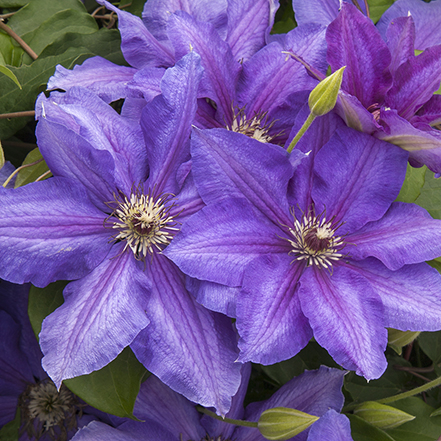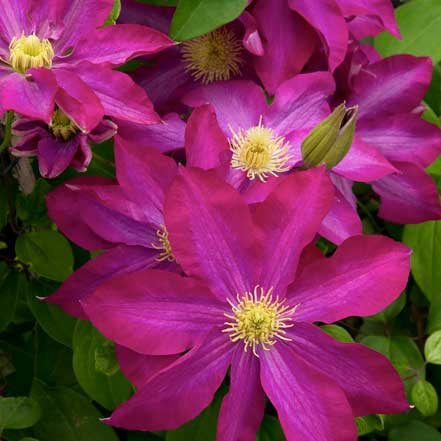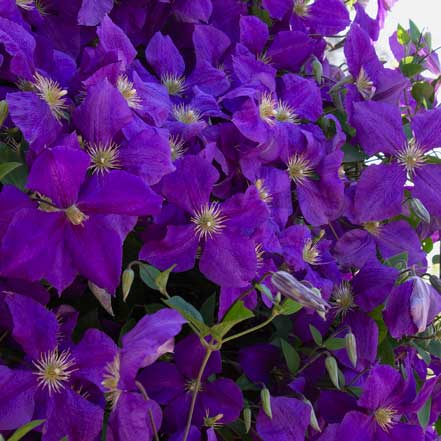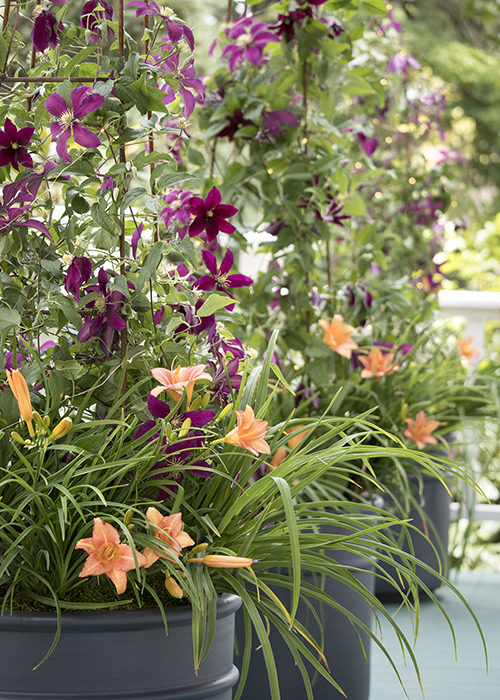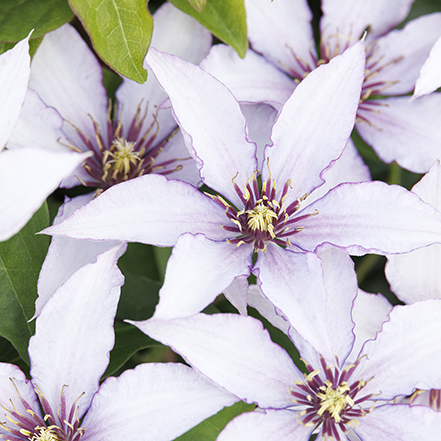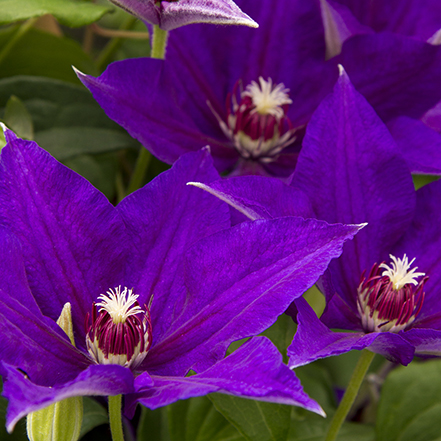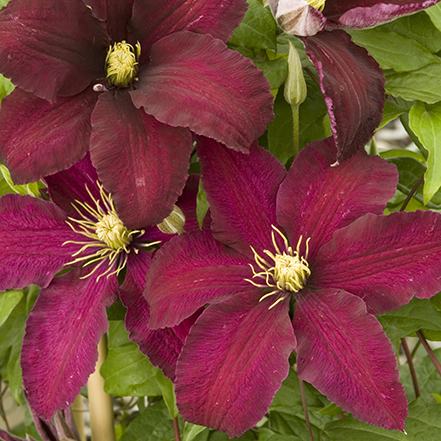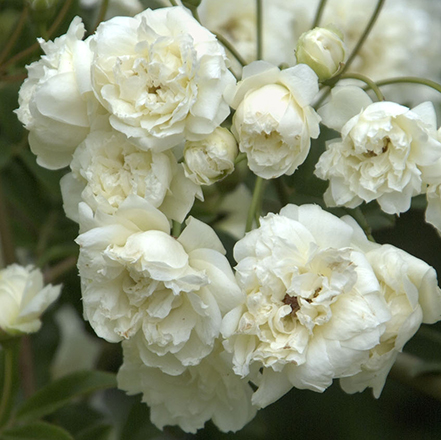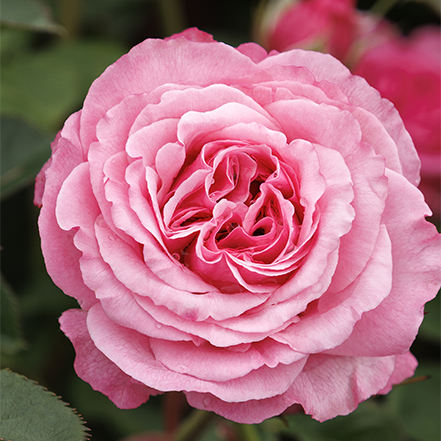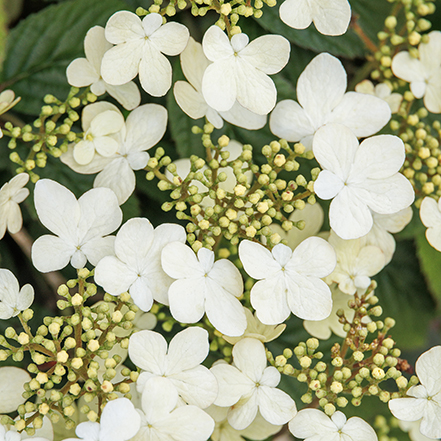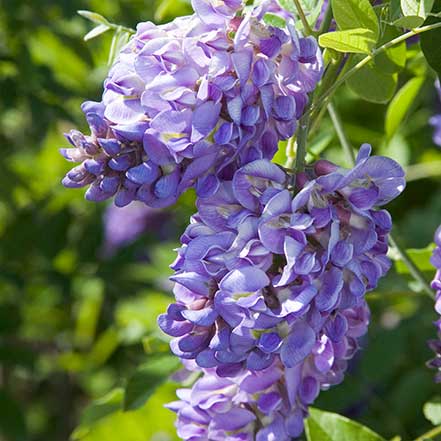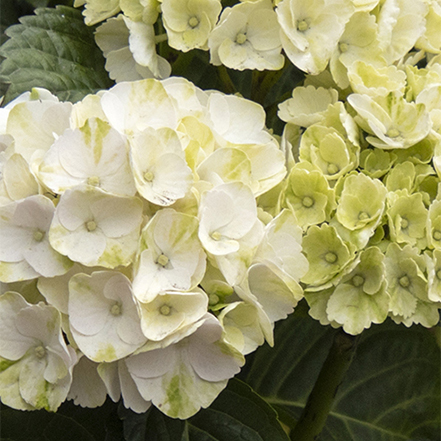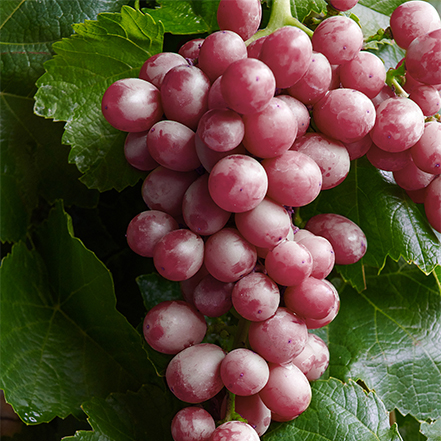Frilly doubles, bell-shapes and star-like singles. Big as your hand or small and delicate. Kissing the sky or hugging the ground. White, pink, red, burgundy, lavender, deep purple and even yellow blooms. Clematis is a plant that, if your climate permits, belongs in every garden.
(Above) Apple Blossom Clematis blooms early to mid-spring, and provides year-round interest with evergreen foliage. Vigorous, twining stems reach 20-25' long. Zones 7-9.
Whether climbing a wall, wrapping a mailbox, scrambling a trellis or cascading over an arch or arbor, clematis are easy-to-grow vines. They add cottage-garden charm, blooming at different times of the season depending on the specific variety.
Because they're so "extra," we know you'll want to extend the flower show beyond the bloom time of a single type (there are three groups of clematis—see below). You can have a reliable sequence of bloom from spring into early fall by planting a mix of varieties. Here's what you need to know to achieve up to 5 months of clematis color.
What are Clematis Groups and Why Do They Matter?
(Above) Jackman Clematis is a Group 3 clematis, and blooms later in the season. Cut it back in late winter or early spring to stimulate new growth.
Clematis varieties are classified into three groups according to blooming time and characteristics. Group 1 (spring bloomers), Group 2 (repeat bloomers), and Group 3 (summer or fall bloomers). This is important information for a few reasons including knowing when your vine will bloom and when is the correct time to prune.
The long flowering season begins with C. alpinas and C. macropetalas in early spring then come the large-flowered hybrids through early summer. Late summer is when C. texensis and C. viticella varieties zoom into bloom.
The clematis season wraps up with exuberant C. paniculata which produces an Instagram-worthy waterfall of white blooms. You can achieve months of color by combining plants from the different groups of clematis. Add in some fabulous companion plants (see ideas below) and your yard will be the first stop on the next garden tour.
The Three Clematis Groups Explained
Group 1
Group 1 are the early flowering types, like C. alpina. C. macropetala, which have single, or double bell-shaped flowers. Lastly some C. montana, with large saucer-shaped flowers. These bloom on old wood and are all no-prune clematis.
Group 2
Group 2 are clematis which flower early to mid-summer and sometimes with a second flush mid to late summer. This group of clematis have upright single, double saucer-shaped flowers and are often very showy. These bloom first on old wood and then again on new. Prune only as needed to shape and remove weak growth, late winter to early spring.
Group 3
Group 3 are the later flowering clematis which have large saucer-shaped flowers in summer and early autumn. Within this group, there are also small flowering clematis. They have a variety of flower shapes, saucer, star-shaped, bell and open bell and also tulip and tubular. These bloom on new growth and can be hard pruned back to 12" in late winter or early spring.
Top Clematis Tip: Mix and Match Clematis Types for Months of Color
To create a near-seamless show of clematis in bloom, you will be picking and choosing from amongst the above groups. Mixing and matching based on bloom time, height, and habit. Planting early, mid-season and late blooming clematis is not difficult. It does take some advance planning to ensure a sequence of blooms though.
A word of advice about planting different groups (as defined above) together; each has its own set of pruning needs. If you do not live in an area where clematis dies back to the ground and is hard pruned, take care. Make sure to space clematis from different groups so the vines do not become intertwined. If you are planting several clematis from the same group, this is not a concern.
Clematis can get "bare knees" as they grow to maturity. One perfect way to solve this is to add a clematis from The Boulevard® collection. Showy repeat bloomers produce a profusion of blooms from ground to sky. They can help fill in at the base of plants. Again, be aware that these are group 3 clematis. These flower on new growth and should be cut back to 12" in early spring.
Here are just three ideas for gorgeous combinations of clematis. These bloom at different times and with a variety of mature heights. Each yielding a promise of the biggest, baddest blooming bounty.
Best Clematis with Luminous Blooms
Gleaming in the moonlight, the marriage of white and near-white varieties of clematis bloom in early spring, summer and fall. All providing a wash of color on trellises and walls.
Vancouver™ Fragrant
Star Clematis
Soft vanilla scent from pure white, late-spring flowering blossoms with red stamens. Up to 8' tall. Zones 4-8.
Boulevard® Acropolis™
Clematis
Soft blue, almost white blooms from top to bottom of this compact vine, early summer to fall. Up to 4' tall. Zones 4-9.
Combine These Clematis Types for 5 Months of Color
For sheer impact of clematis doing its thing, not much can match the grouping of three large-flowered varieties timed to bloom in sequence. (And, purple pretty much goes with everything!)
Vancouver™ Starry
Nights Clematis
Huge 8-inch blooms in brilliant purple-blue with red highlights. Blooms early spring, repeats to fall. Up to 10' tall. Zones 4-9
Pink Champagne
Clematis
Deep-pink flowers up to eight inches diameter. Blooms early summer, and repeats into fall. Up to 8' tall. Zones 4-9.
Jackman Superba
Clematis
Avalanche of large, deep violet-purple flowers continuously from summer through fall. Up to 12' tall. Zones 4-9.
Best Clematis for Containers
Clematis can be grown in large containers (18" diameter minimum and deep enough to insert supports) as long as you provide sturdy support such as a trellis, obelisk, or tuteur.
Compact clematis is perfect for growing in containers. Look for varieties that top out at 12' tall or shorter at maturity to ensure your containers don't get overrun with a vigorous clematis that requires more space to sprawl. Boulevard® Clematis are favorites for containers because they only grow up to 5' tall, so you don't have to worry about them getting too big for their containers.
Pictured here is Niobe Clematis, which has a bushier habit than the traditional clematis vining habit. This makes it ideal for containers. Here, it's combined with a dwarf daylily to create a colorful container that checks all the "thriller, filler, and spiller" boxes.
Boulevard® Samaritan Jo™
Clematis
Abundant, purple-accented white flowers with pointed petals on this compact climber. Blooms spring through early fall. Up to 5' tall. Zones 4-9.
Vancouver™ Danielle
Clematis
Brilliant violet-blue flower color on a vigorous vine. Blooms in spring, repeats in fall. Up to 7' tall. Zones 4-9.
Niobe
Clematis
Leathery, textured foliage and large wine-red blooms that don't fade in the sun. Blooms late spring and summer. Up to 12' tall. Zones 4-9.
Top Tips for Growing Clematis
Clematis is such a diverse group of plants that there's one for virtually every situation. When you buy a Monrovia clematis you are already ahead of the game. Each pot contains several vines grown in a custom soil mix for a great head start.
Caring for clematis is not any more difficult than many other vining plants. As long as you remember a few things:
- Clematis famously like "head in the sun, feet in the shade." Therefore, lay stones around the base of the plant or add annuals or perennials.
- Clematis is deep rooted so water slowly and thoroughly if it doesn't rain.
- Once planted, clematis likes to stay put. Yes, you can transplant, but do so only if necessary and use great care.
- Adhere to a pruning schedule based on the type of clematis (see above).
If your clematis is stubbornly refusing to bloom (it happens!) see if any of these apply:
- Pruning at the incorrect time thereby accidently snipping off the buds
- Clematis loves to eat. Although too much nitrogen fertilizer can come at the expense of flowers (typically food for roses is a good choice)
- Inadequate soil nutrients (get a soil test—it's not expensive and can help)
- Not enough light. Yes, some clematis can tolerate shade but they set more flowers with full sun
- They're just too young. Immature plants are spending their time setting deep roots, not making flowers. Patience, friend.
Clematis Companion Plants
As if clematis weren't already an object of desire for so many of us, the ways she loves to wind her way up, over, across, and through other beautiful, sturdy plants that can stand up to her fast growing nature makes us want one for every corner of the garden. Here are just six easy-care plants that pair well with a variety of clematis (make sure light needs, heights and habits are compatible).
White Lady Banks
Climbing Rose
Blooms in spring to early summer; does not repeat. The perfect foil for later clematis. Up to 20' tall. Zones 6-9.
Heavenly Ascent®
Pink Climbing Rose
Large, very fragrant roses bloom spring through fall on this disease-resistant rose. Up to 8' tall. Zones 5-9.
Summer Snowflake
Viburnum
Layered branches create an ideal structure for enthusiastic clematis. Up to 10' tall and wide. Zones 5-8.
Amethyst Falls
American Wisteria
Spring bloomer with stems made great for tall clematis to wind around. Up to 20' tall. Zones 5-9.
Seaside Serenade® Cape
Lookout Hydrangea
Green-aging-to-white blooms paired with clematis? Wow. Up to 3' tall and wide. Zones 4-9.
Zestful™ Lollipop
Grape
Fast-growing, sturdy vine can accommodate even the most scramble-happy clematis. Up to 25' tall. Zones 7-9.
Learn More
- See all clematis varieties
- Browse our blog for more stories about how to landscape your yard.
- Shop our entire assortment of plants for your garden.
- For more inspiration and information, please subscribe to our monthly newsletter.
- To find a Monrovia retailer.
Related posts:
Late summer blooming clematis ideas




